 W
WNikola Altomanović was a 14th-century Serbian župan of the House of Vojinović. He ruled the areas from Rudnik, over Polimlje, Podrinje, east Herzegovina with Trebinje, reaching as far as Konavle and Dračevica, neighboring the Republic of Dubrovnik. He was defeated and blinded in Užice in 1373 by a coalition of his Serbian and Bosnian royals neighbors supported by the king of Hungary.
 W
WThe Balšić was a noble family that ruled "Zeta and the coastlands", from 1362 to 1421, during and after the fall of the Serbian Empire. Balša, the founder, was a petty nobleman who held only one village during the rule of Emperor Dušan the Mighty, and only after the death of the emperor, his three sons gained power in Lower Zeta after acquiring the lands of gospodin Žarko under unclear circumstances, and they then expanded into Upper Zeta by murdering voivode and čelnik Đuraš Ilijić. Nevertheless, they were acknowledged as oblastni gospodari of Zeta in edicts of Emperor Uroš the Weak. After the death of Uroš (1371), the family feuded with the Mrnjavčevići, who controlled Macedonia. In 1421, Balša III, on his death, passed the rule of Zeta to his uncle, Despot Stefan the Tall.
 W
WBalša Balšić, known in historiography as Balša II, was the Lord of Lower Zeta from 1378 to 1385. He managed to expand his borders towards the south; defeating the Albanian duke Karl Thopia.
 W
WThe Balšić was a noble family that ruled "Zeta and the coastlands", from 1362 to 1421, during and after the fall of the Serbian Empire. Balša, the founder, was a petty nobleman who held only one village during the rule of Emperor Dušan the Mighty, and only after the death of the emperor, his three sons gained power in Lower Zeta after acquiring the lands of gospodin Žarko under unclear circumstances, and they then expanded into Upper Zeta by murdering voivode and čelnik Đuraš Ilijić. Nevertheless, they were acknowledged as oblastni gospodari of Zeta in edicts of Emperor Uroš the Weak. After the death of Uroš (1371), the family feuded with the Mrnjavčevići, who controlled Macedonia. In 1421, Balša III, on his death, passed the rule of Zeta to his uncle, Despot Stefan the Tall.
 W
WGradislav Borilović was a Serbian magnate in the service of Stefan Uroš III Dečanski and Stefan Dušan, having the titles of vojvoda (general), kaznac, and tepčija. Gradislav led the Serbian army that fought the Ottoman emirate at the Battle of Demotika in October 1352. The battle was fought between the allies of the two rival Byzantine Emperors, John V Palaiologos and John VI Kantakouzenos, and it was the first major battle of the Ottomans on European soil, which ended in a Serbian defeat. Greek sources spoke of Gradislav as "truly one of the most respectable among the Serbs".
 W
WVuk Branković was a Serbian medieval nobleman who, during the Fall of the Serbian Empire, inherited a province that extended over present-day southern and southwestern Serbia, entire Kosovo, the northern part of present day Republic of North Macedonia, and northern Montenegro. His fief was known as Oblast Brankovića or simply as Vukova zemlja, which he held with the title of gospodin, under Prince Lazar of Serbia. After the Battle of Kosovo (1389), Vuk was briefly the de facto most powerful Serbian lord.
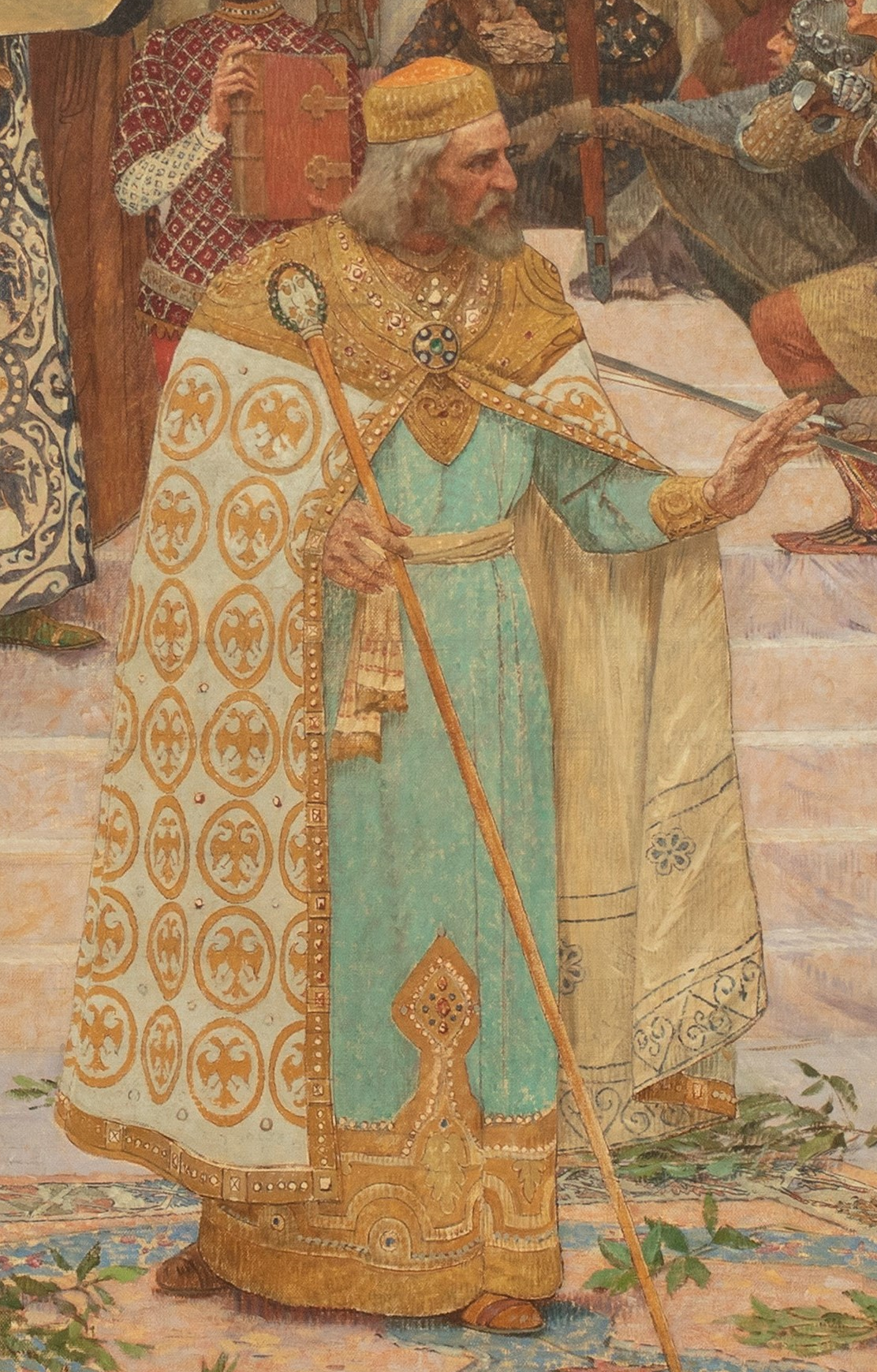 W
WNikola Buća was a Serbian nobleman, merchant from Kotor, and protovestijar in the service of King Stephen Uroš III Dečanski of Serbia and Emperor Stephen Dušan the Mighty.
 W
WDejan was a Serbian magnate who served Emperor Stefan Dušan as sevastokrator, and Emperor Uroš V as despot. He was married to Emperor Dušan's sister Teodora, and possessed a large province in the Kumanovo region, east of Skopska Crna Gora. It initially included the old župe (counties) of Žegligovo and Preševo. Uroš V later gave Dejan the Upper Struma river with Velbužd (Kyustendil). Dejan built the Zemen Monastery, among others, and reconstructed several church buildings throughout his province.
 W
WKonstantin (Kostadin) Dejanović was a Serbian magnate that ruled a large province in eastern Macedonia under Ottoman suzerainty, during the fall of the Serbian Empire. He succeeded his older brother Jovan Dragaš, who had been an Ottoman vassal since the Battle of Maritsa (1371) which had devastated part of the Serbian nobility. The brothers had their own government and minted coins according to the Nemanjić style. His daughter Jelena married Byzantine Emperor Manuel II Palaiologos in 1392. He fell at the Battle of Rovine, serving the Ottomans against Wallachia, fighting alongside Serbian magnates Stefan Lazarević and Marko Mrnjavčević.
 W
WThe Dejanović or Dragaš, originates from a medieval noble family that served the Serbian Empire of Dušan the Mighty and Uroš the Weak, and during the fall of the Serbian Empire, after the Battle of Maritsa (1371), it became an Ottoman vassal. The family was one of the most prominent during these periods. The family held a region roughly centered where the borders of Serbia, Bulgaria and North Macedonia meet. The last two Byzantine Emperors were maternal descendants of the house.
 W
WĐurađ Balšić, also known as Đurađ I was the Lord of Zeta between 1362 and 13 January 1378. He was the eldest of the three sons of Balša I, and belonged to the Balšić family.
 W
WJovan Dejanović, known as Jovan Dragaš, was a Serbian nobleman that held the title of despot under the Serbian Emperor Uroš V, his maternal uncle. He later became an Ottoman vassal after the Battle of Maritsa in 1371.
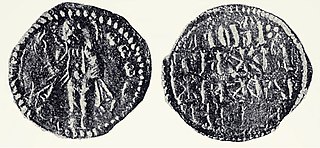 W
WAndrea Gropa was a 14th-century nobleman who ruled the region and the city of Ohrid, first as a minor vassal (župan) to Serbian King Vukašin Mrnjavčević, then as an Ottoman vassal after the Battle of Maritsa. He hailed from the noble Gropa family.
 W
WThe Lazarević was a Serbian medieval royal family, which ruled Moravian Serbia and the Serbian Despotate.
 W
WĐuraš Ilijić was a nobleman who served the Serbian monarchs Stefan Dečanski, Stefan Dušan and Uroš V, from 1326 until his death in 1362. He had the title of čelnik ("head"), and governed Upper Zeta. He is an ancestor of the Crnojević noble family.
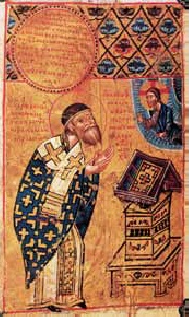 W
WJakov of Serres was a medieval Serbian writer, scholar, translator, and hierarch of the Serbian Orthodox Church, one of the most important men of letters working in the 14th century.
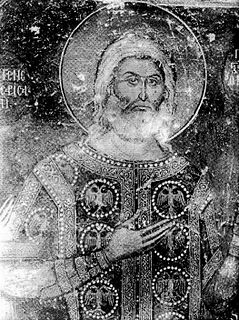 W
WNovak the Serb was a 14th-century Serbian nobleman that held the region of Lake Prespa during the Serbian Empire of Uroš the Weak. He held the title of Caesar, and is hence also known as Kesar Novak.
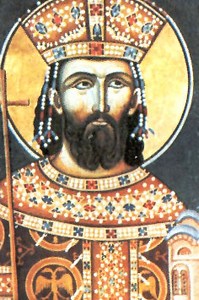 W
WPrince Lazar Hrebeljanović was a medieval Serbian ruler who created the largest and most powerful state on the territory of the disintegrated Serbian Empire. Lazar's state, referred to by historians as Moravian Serbia, comprised the basins of the Great Morava, West Morava, and South Morava rivers. Lazar ruled Moravian Serbia from 1373 until his death in 1389. He sought to resurrect the Serbian Empire and place himself at its helm, claiming to be the direct successor of the Nemanjić dynasty, which went extinct in 1371 after ruling over Serbia for two centuries. Lazar's programme had the full support of the Serbian Orthodox Church, but the Serbian nobility did not recognize him as their supreme ruler. He is often referred to as Tsar Lazar Hrebeljanović ; however, he only held the title of prince.
 W
WLazar, also known as Lazar the Serb or Lazar the Hilandarian, was a Serbian Orthodox monk and horologist who invented and built the first known mechanical public clock in Russia in 1404. The clock, which also struck the hours, was built at the request of Grand Prince Vasily I of Moscow. Prior to his arrival in Moscow, Lazar had served as a monk in the Serbian Hilandar monastery at Mount Athos. The clock tower was located in the palace behind the Cathedral of the Annunciation. However, the clock and the church in which it was located have not survived.
 W
WBranko was a Serbian magnate who served king and emperor Stefan Dušan, and emperor Stefan Uroš V, with the titles of sluga and later sevastokrator. A member of an old and respectable family, possibly descending from the Serbian dynasty itself, Branko began his royal service in the nearest circle of the ruler. After the elevation of the Serbian state to an empire (1346), Branko received the second-highest court title, sevastokrator, usually given to relatives. He governed the Ohrid region. Branko had three sons and a daughter, of whom Vuk Branković would become an important person in the period of the Fall of the Serbian Empire.
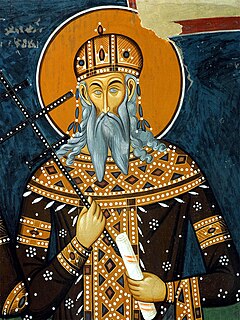 W
WVukašin Mrnjavčević was King of Serbia as the co-ruler of Stefan Uroš V from 1365 to 1371. Principal domains of king Vukašin and his family were located in southern parts of medieval Serbia and northwestern parts of the historical region of Macedonia.
 W
WThe Musić was a Serbian noble house that served the Serbian Empire (1345–1371), and during its fall (1371–1389) it served Tsar Lazar's Serbia. The eponymous founder was čelnik Musa, who married Dragana Hrebeljanović, the sister of Tsar Lazar. Stefan and Lazar Musić, the sons of Musa, held a region of roughly modern Raška municipality and north Kosovo. The brothers died fighting the Ottoman Empire in the Battle of Kosovo (1389).
 W
WVratko Nemanjić fl. 1325-1355) was a Serbian noble, father of Prince Lazar's spouse Milica. Serbian epic poetry identifies him with Yug Bogdan or Ljutica Bogdan, a mythical hero in the Battle of Kosovo.
 W
WJovan Oliver Grčinić was a magnate of the Serbian Emperor Dušan the Mighty, holding the titles of sebastokrator and despotes, and the rank of "great voivode", showing his prominence and status as one of the most important nobles of Dušan. Oliver supported Dušan in the succession war against his father, and was one of the supreme generals in the southern military expeditions. His province included Ovče Pole and the left bank of the Vardar. After the death of Emperor Dušan, there are no more mentions of Oliver. During the fall of the Serbian Empire, his lands were held by the Dejanovići.
 W
WPalman was a German noble (dominus), knight, and mercenary commander of the Alemannic Guard in the Serbian Imperial army of one of the most prolific European rulers of its time, Dušan the Mighty (r.1331–1355).
 W
WPaskač was a Serbian nobleman that served the Serbian Empire, with the title of knez. Together with his son, sevastokrator Vlatko, he founded the Psača Monastery, in which the ktetor fresco of his family has been preserved, painted between 1365 and 1371. He is depicted as an old man, grey-haired, holding the church model together with Vlatko in the centre. By Paskač is his wife, noblewoman Ozra, and also their grandson, Uglješa. The family is wearing rich clothing. Nothing else is known of Paskač; he is not mentioned in donation charters. His function in the state is unknown, and it is unknown in which capacity he received the title of knez. Mandić theorizes that if Paskač was a magnate, he would have succeeded Vojislav as the veliki knez, then Lazar could have received that title after Paskač's death, possibly during the Empire. The fresco composition is valued highly, and is, as other 14th-century works, part of several special studies.
 W
WPreljub was a Serbian magnate who served Emperor Stefan Dušan as vojvoda (general). He participated in the southern conquests and held Thessaly with the rank of caesar (kesar) in 1348–56. His son Thomas Preljubović was Despot of Epirus in 1366–84.
 W
WPreljub was a Serbian magnate who served Emperor Stefan Dušan as vojvoda (general). He participated in the southern conquests and held Thessaly with the rank of caesar (kesar) in 1348–56. His son Thomas Preljubović was Despot of Epirus in 1366–84.
 W
WPribil was a Serbian župan (count) who built the Dobrun Monastery in Dobrun, Višegrad, as a family funeral church. He founded the church together with his sons, župan Petar and župan Stefan. There are frescoes of the family, and of a higher-ranked nobleman, protovestijar Stan, who was Pribil's father-in-law.
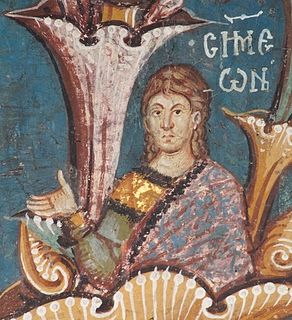 W
WSimeon Uroš, nicknamed Siniša (Синиша), was a self-proclaimed Emperor of Serbs and Greeks, from 1356 to 1370. He was son of Serbian King Stefan Dečanski and Byzantine Princess Maria Palaiologina. Initially, he was awarded the title of despot in 1346, and appointed governor of southern Epirus and Acarnania in 1347 by his half-brother, Serbian Emperor Stefan Dušan. After Dušan's death in 1355, the Serbian throne passed to Dušan's son Stefan Uroš V, but despot Simeon decided to seize the opportunity in order to impose himself as co-ruler and lord of all southern provinces of the Serbian Empire. That led him to conflict with his nephew in 1356, when Simeon started to expand his control in southern regions of the Empire, trying to take Thessaly and Macedonia. He proclaimed himself Emperor of the Serbs and Greeks, creating a separate state, centered in regions of Thessaly and Epirus, where he ruled until his death in 1370. He was succeeded by his son Jovan Uroš.
 W
WMarina Smilets was the eldest daughter of tsar Smilets of Bulgaria and his Byzantine wife, tentatively called Smiltsena Palaiologina.
 W
WPribil was a Serbian župan (count) who built the Dobrun Monastery in Dobrun, Višegrad, as a family funeral church. He founded the church together with his sons, župan Petar and župan Stefan. There are frescoes of the family, and of a higher-ranked nobleman, protovestijar Stan, who was Pribil's father-in-law.
 W
WUglješa Vlatković was a Serbian nobleman from the late 14th and early 15th centuries. He had the title of kesar (caesar) and ruled over the area of Inogošt, Preševo and Vranje.
 W
WMiloš Vojinović was a Serbian nobleman who served Emperor Stefan Dušan as stavilac, the son of general Vojin and brother of Vojislav and Altoman. He is a hero of the pre-Kosovo cycle in Serbian epic poetry.